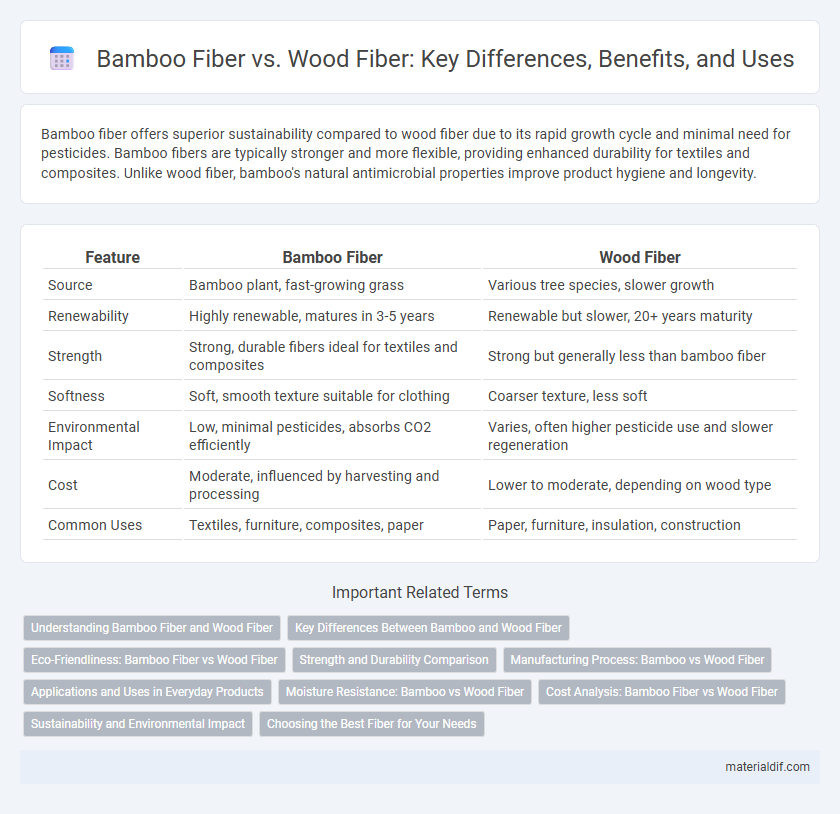Bamboo fiber offers superior sustainability compared to wood fiber due to its rapid growth cycle and minimal need for pesticides. Bamboo fibers are typically stronger and more flexible, providing enhanced durability for textiles and composites. Unlike wood fiber, bamboo's natural antimicrobial properties improve product hygiene and longevity.
Table of Comparison
| Feature | Bamboo Fiber | Wood Fiber |
|---|---|---|
| Source | Bamboo plant, fast-growing grass | Various tree species, slower growth |
| Renewability | Highly renewable, matures in 3-5 years | Renewable but slower, 20+ years maturity |
| Strength | Strong, durable fibers ideal for textiles and composites | Strong but generally less than bamboo fiber |
| Softness | Soft, smooth texture suitable for clothing | Coarser texture, less soft |
| Environmental Impact | Low, minimal pesticides, absorbs CO2 efficiently | Varies, often higher pesticide use and slower regeneration |
| Cost | Moderate, influenced by harvesting and processing | Lower to moderate, depending on wood type |
| Common Uses | Textiles, furniture, composites, paper | Paper, furniture, insulation, construction |
Understanding Bamboo Fiber and Wood Fiber
Bamboo fiber is derived from the fast-growing bamboo plant, offering natural antibacterial properties and superior moisture-wicking capabilities compared to traditional wood fiber, which is extracted from hardwood trees and often undergoes intensive chemical processing. Bamboo fibers are typically softer, more breathable, and more sustainable due to bamboo's rapid renewability and lower environmental impact, while wood fibers tend to provide greater structural strength but may contribute more to deforestation and longer regeneration cycles. Understanding these differences is crucial for industries seeking eco-friendly, durable, and skin-friendly textile or paper materials.
Key Differences Between Bamboo and Wood Fiber
Bamboo fiber offers superior tensile strength and faster growth rates compared to traditional wood fiber, making it a more sustainable resource. The hollow structure of bamboo fibers contributes to enhanced breathability and moisture-wicking properties, while wood fibers tend to be denser and less flexible. Bamboo's renewable harvesting cycle of 3-5 years contrasts with wood's longer maturation period, significantly impacting environmental impact and raw material availability.
Eco-Friendliness: Bamboo Fiber vs Wood Fiber
Bamboo fiber stands out for its rapid renewability, with bamboo plants reaching maturity in 3 to 5 years compared to trees, which often take decades, significantly reducing environmental impact. Bamboo cultivation requires minimal pesticides and fertilizers, promoting healthier soil and biodiversity, whereas wood fiber production typically involves deforestation and habitat loss. The biodegradability of bamboo fiber and its lower water consumption in processing further highlight its superior eco-friendliness compared to traditional wood fiber sources.
Strength and Durability Comparison
Bamboo fiber exhibits superior tensile strength compared to wood fiber, making it an ideal material for construction and textile industries requiring high durability. Its natural structure provides greater resistance to wear, moisture, and environmental stress, resulting in enhanced longevity over wood fiber. Bamboo fiber's rapid growth and renewable properties also contribute to sustainable strength applications in composites and engineered products.
Manufacturing Process: Bamboo vs Wood Fiber
Bamboo fiber production involves mechanical crushing and enzymatic treatment to separate fibers with minimal chemical use, resulting in a sustainable and eco-friendly process. Wood fiber manufacturing typically requires extensive chemical pulping and bleaching, leading to higher environmental impact and energy consumption. Bamboo's rapid growth and efficient processing offer a more sustainable alternative to traditional wood fiber in textile and composite industries.
Applications and Uses in Everyday Products
Bamboo fiber is widely used in textiles due to its softness, antibacterial properties, and moisture-wicking abilities, making it ideal for clothing, towels, and bedding. Wood fiber, derived from trees like pine or eucalyptus, is commonly utilized in paper production, packaging materials, and composite products such as fiberboard. Both fibers offer sustainable alternatives, with bamboo providing faster growth cycles and natural durability, while wood fibers contribute strength and rigidity in industrial applications.
Moisture Resistance: Bamboo vs Wood Fiber
Bamboo fiber exhibits superior moisture resistance compared to traditional wood fiber, making it a preferred choice in humid environments and applications prone to water exposure. The natural silica content in bamboo enhances its water-repellent properties, reducing the risk of mold and decay over time. Wood fiber, while durable, tends to absorb more moisture, leading to swelling and structural degradation when exposed to damp conditions.
Cost Analysis: Bamboo Fiber vs Wood Fiber
Bamboo fiber offers a cost-effective alternative to traditional wood fiber due to its rapid growth rate and higher yield per acre, reducing raw material expenses significantly. Manufacturing processes for bamboo fiber often require less energy and chemicals, leading to lower production costs compared to wood fiber. Economically, bamboo fiber presents advantages in sustainability and resource efficiency, making it a competitive option in industries like textiles and construction.
Sustainability and Environmental Impact
Bamboo fiber is significantly more sustainable than wood fiber due to bamboo's rapid growth rate, which allows for faster harvesting cycles and less deforestation. Bamboo cultivation requires minimal pesticides and fertilizers, reducing soil and water pollution compared to traditional wood forestry. The lower carbon footprint of bamboo fiber production also contributes to its environmentally friendly profile, making it a preferable choice for sustainable textiles and materials.
Choosing the Best Fiber for Your Needs
Bamboo fiber offers superior softness, breathability, and natural antibacterial properties compared to wood fiber, making it ideal for textiles and eco-friendly products. Wood fiber, derived mainly from hardwoods, provides excellent durability and strength, often used in construction and paper manufacturing. Evaluating your priorities in softness, sustainability, and strength will guide the choice between bamboo fiber and wood fiber for the best application.
Bamboo Fiber vs Wood Fiber Infographic

 materialdif.com
materialdif.com